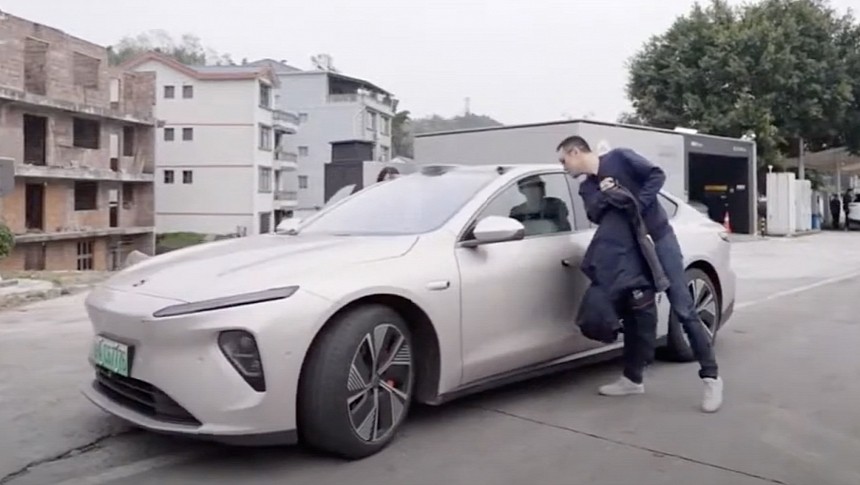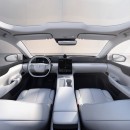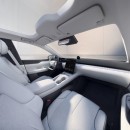The Nio ET7 has just traveled almost 650 miles on a single charge and could go for 18 miles more before the battery died out. The test was live-streamed, with the CEO of the carmaker behind the wheel.
It was William Li, Nio's co-founder and CEO, who tested the ET7 electric sedan, equipped with the new semi-solid state battery (SSB) with a capacity of 150 kWh.
The car was capable of driving 1,044 kilometers, the equivalent of 649 miles. When Li and his co-driver, Shen Fee, Director of Nio Power, decided to pull over, there was 3 percent of the battery energy left. That means that the car would have likely been able to travel 30 kilometers (18.6 miles) more.
The drive was live-streamed online, starting on Sunday morning at 6:30. They started off at the battery swap station in Shanghai and finished in Xiamen.
The temperature during the test ranged between - 2 degrees, early morning in Shanghai, and 12 degrees Celsius (28 to 54 degrees Fahrenheit) at mid-day. The two occupants kept the average cabin temperature at 20 degrees Celsius (68 degrees Fahrenheit).
The 150 kWh battery pack had already been tested on a route between Kunming and Beihai, according to William Li. The car drove more then, covering 1,145 kilometers (711.4 miles).
Most of the time (92 percent / 957 kilometers / 595 miles), the ET7 drove with the Navigate-on-Pilot (NOP) engaged at a maximum speed of 90 kph (56 mph), with an energy consumption of 13.2 kWh/100 km (13.2 kWh/62 miles). The average speed of the entire speed was 83.9 kph (51.2 mph). The trip took 12.4 hours or 14 hours with stops and breaks.
The solid-state battery that the car was equipped with was developed by Chinese battery manufacturer WeLion. With a cooling system, which is six times more efficient than ordinary batteries, the unit has a density of 260 Wh/kg and weighs 575 kilograms (1,268 pounds).
The carmaker currently equips its models with either 75 or 100 kWh battery packs. The 150 kWh unit has a much bigger capacity but has the exact same dimensions as the smaller packs and can be transplanted into any of the Nio models. The battery swap would take around three minutes.
Nio is working on models underpinned by the new NT1 and NT2 architectures, tested and certified to get the new 150 kWh battery. The mass production of the new unit will start in April 2024, and it will be very expensive. Nio President Qin Lihong claims that the cost of the battery will be equivalent to that of the ET5 mid-size electric sedan, which starts at 328,000 yuan ($46,000) in China.
Right now, the production vehicle with the best range is the 2023 Lucid Air Touring. It can drive as far as 516 miles (830 kilometers) on a single charge.
The car was capable of driving 1,044 kilometers, the equivalent of 649 miles. When Li and his co-driver, Shen Fee, Director of Nio Power, decided to pull over, there was 3 percent of the battery energy left. That means that the car would have likely been able to travel 30 kilometers (18.6 miles) more.
The drive was live-streamed online, starting on Sunday morning at 6:30. They started off at the battery swap station in Shanghai and finished in Xiamen.
The temperature during the test ranged between - 2 degrees, early morning in Shanghai, and 12 degrees Celsius (28 to 54 degrees Fahrenheit) at mid-day. The two occupants kept the average cabin temperature at 20 degrees Celsius (68 degrees Fahrenheit).
The 150 kWh battery pack had already been tested on a route between Kunming and Beihai, according to William Li. The car drove more then, covering 1,145 kilometers (711.4 miles).
Most of the time (92 percent / 957 kilometers / 595 miles), the ET7 drove with the Navigate-on-Pilot (NOP) engaged at a maximum speed of 90 kph (56 mph), with an energy consumption of 13.2 kWh/100 km (13.2 kWh/62 miles). The average speed of the entire speed was 83.9 kph (51.2 mph). The trip took 12.4 hours or 14 hours with stops and breaks.
The solid-state battery that the car was equipped with was developed by Chinese battery manufacturer WeLion. With a cooling system, which is six times more efficient than ordinary batteries, the unit has a density of 260 Wh/kg and weighs 575 kilograms (1,268 pounds).
The carmaker currently equips its models with either 75 or 100 kWh battery packs. The 150 kWh unit has a much bigger capacity but has the exact same dimensions as the smaller packs and can be transplanted into any of the Nio models. The battery swap would take around three minutes.
Nio is working on models underpinned by the new NT1 and NT2 architectures, tested and certified to get the new 150 kWh battery. The mass production of the new unit will start in April 2024, and it will be very expensive. Nio President Qin Lihong claims that the cost of the battery will be equivalent to that of the ET5 mid-size electric sedan, which starts at 328,000 yuan ($46,000) in China.
Right now, the production vehicle with the best range is the 2023 Lucid Air Touring. It can drive as far as 516 miles (830 kilometers) on a single charge.












